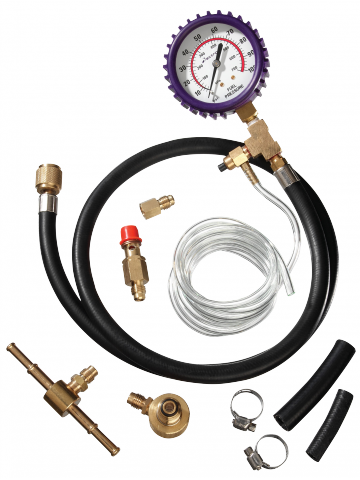
Fuel Injection System Theory
There are two basic types of fuel injection systems currently being used by GM, Ford, and Chrysler. The first type is called "port" or "multi-port" fuel injection. In this system, the fuel injectors spray fuel directly into the intake manifold behind the intake valve. These systems typically have one fuel injector per cylinder. The second type is commonly called Throttle Body Injection (TBI) for GM and Chrysler vehicles or Central Fuel Injection (CFI) for Ford vehicles. These systems use one or two fuel injectors mounted on top of the intake manifold. They spray fuel into the throttle body similarly to a conventional carburetor.
Fuel System Components
Before doing any fuel pressure testing, it is a good idea to understand how fuel system components work and how they relate to one another. The fuel pump pumps fuel from the fuel tank to the fuel pressure regulator and fuel injectors. The fuel pressure regulator divides fuel between the pressure line and the return line. The fuel in the pressure line goes to the fuel injectors, while the fuel in the return line is returned to the fuel tank.
General Fuel Pressure Diagnostics
Checking fuel pressure is an essential part of fuel injection system troubleshooting. High fuel pressure will make an engine run rich, while low fuel pressure will make an engine run lean or not at all. Fuel pressure readings that are higher than manufacturers specifications are generally caused by a problem in the return line fuel components. Conversely, fuel pressure readings that are lower than manufacturers specifications are generally caused by a problem in the pressure line fuel components. If fuel pressure readings are not within manufacturer's specifications, then refer to a vehicle service manual for step-by-step diagnostic procedures that will pinpoint the faulty component for your specific vehicle.
Possible causes of high fuel pressure readings are the following:
- Faulty fuel pressure regulator.
- Restrictions in return line.
- Faulty fuel line couplings at fuel tank.
Possible causes of low fuel pressure readings are the following:
- Clogged or restricted fuel filter.
- Restriction in pressure line.
- Faulty fuel pump.
- Faulty fuel pump relay.
- Bad fuel pump fuse.
- Faulty fuel pump wiring.
- Clogged or restricted fuel pump filter.
- Faulty fuel pressure regulator.
- Leaking fuel injectors.
- Faulty fuel line couplings at fuel tank.
Recommended Tools
